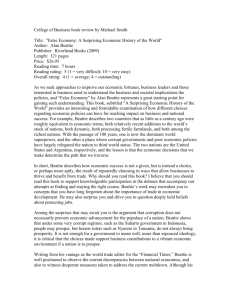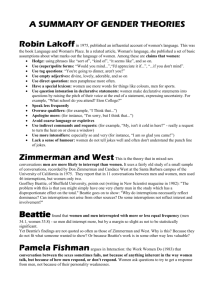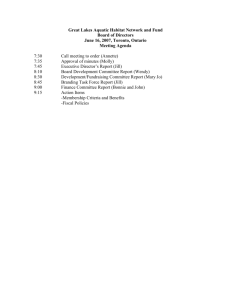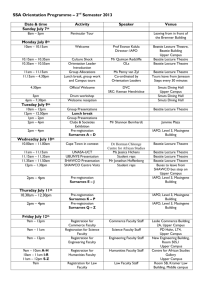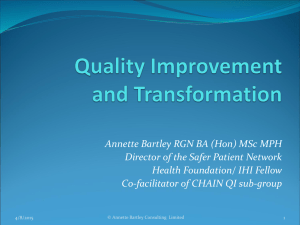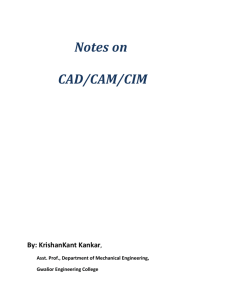Computer Integrated Manufacturing
advertisement
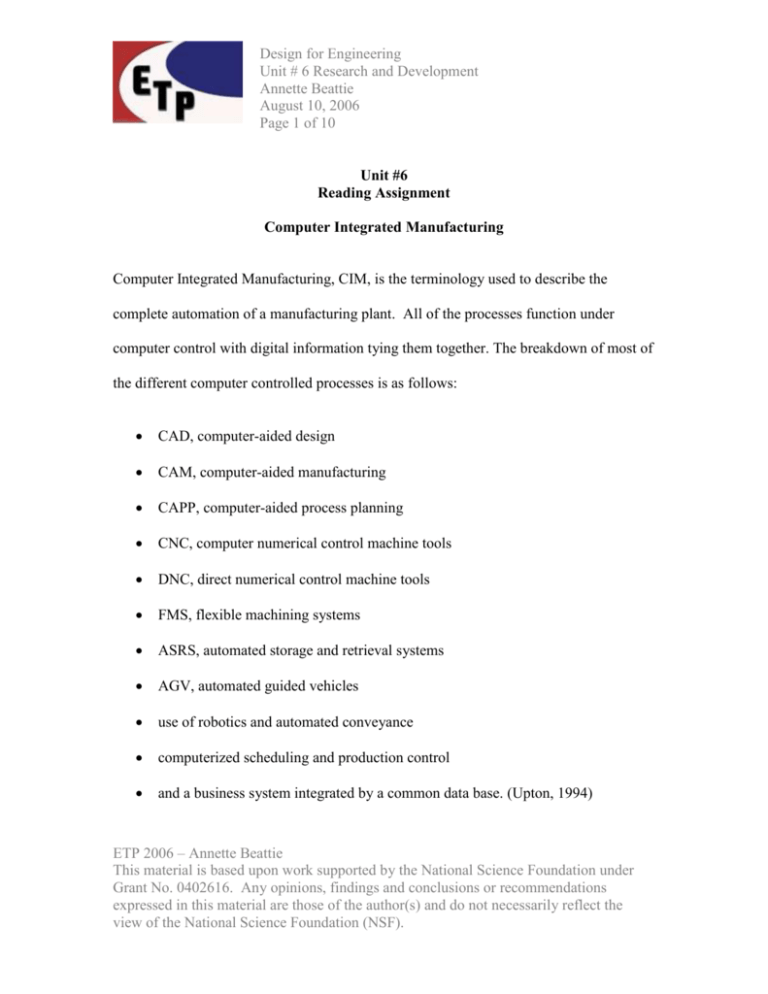
Design for Engineering Unit # 6 Research and Development Annette Beattie August 10, 2006 Page 1 of 10 Unit #6 Reading Assignment Computer Integrated Manufacturing Computer Integrated Manufacturing, CIM, is the terminology used to describe the complete automation of a manufacturing plant. All of the processes function under computer control with digital information tying them together. The breakdown of most of the different computer controlled processes is as follows: CAD, computer-aided design CAM, computer-aided manufacturing CAPP, computer-aided process planning CNC, computer numerical control machine tools DNC, direct numerical control machine tools FMS, flexible machining systems ASRS, automated storage and retrieval systems AGV, automated guided vehicles use of robotics and automated conveyance computerized scheduling and production control and a business system integrated by a common data base. (Upton, 1994) ETP 2006 – Annette Beattie This material is based upon work supported by the National Science Foundation under Grant No. 0402616. Any opinions, findings and conclusions or recommendations expressed in this material are those of the author(s) and do not necessarily reflect the view of the National Science Foundation (NSF). Design for Engineering Unit # 6 Research and Development Annette Beattie August 10, 2006 Page 2 of 10 The heart of CIM is CAD/CAM. Computer-aided design (CAD) and computer-aided manufacturing (CAM) systems reduce cycle times in the business. CAD/CAM is a high technology integrating tool between design and manufacturing. CAD creates similar geometries for quick retrieval. A simple example, if you need to draw a part with a 3/8 in hole in a certain location, the draftsman can click on circle, put in the radius, enter the location coordinates and done. No more measuring for a center of the circle and using a compass while first setting it at just the right diameter, etc. Imagine the ease of a more sophisticated drawing. CAD also allows designers to portray the electronic drawings or images in two dimensions, like a standard blueprint, or as a three dimensional component which can be rotated as it is viewed on a computer screen. Software programs can analyze and test CAD designs before a prototype is made. The software allows engineers to predict stress points on a part and the effects of loading. Once the part has been designed electronically, the graphics can be used by CAM programmers to program the tool path to machine the part from the raw material. The CAM program is then integrated with a CNC machine and the cutting program is produced. ETP 2006 – Annette Beattie This material is based upon work supported by the National Science Foundation under Grant No. 0402616. Any opinions, findings and conclusions or recommendations expressed in this material are those of the author(s) and do not necessarily reflect the view of the National Science Foundation (NSF). Design for Engineering Unit # 6 Research and Development Annette Beattie August 10, 2006 Page 3 of 10 The CAD graphics can also be used to design tools and fixtures. It can also be used for inspections by coordinate measuring machines (CMM). The more a CAD design is used, the more time is saved in the overall process. Flexible manufacturing system (FMS) is an arrangement of machines connected by a transport system. Work is carried to the machines on pallets by the transporter. This makes for accurate, fast and automatic startup. A central computer controls the machines, the transporter, and downloads the machining program. (Upton, 1994) Now, add CAD and CAM with FMS and the CIM concept is well under way. But it also includes assembly, scheduling, and delivery. Here is an example of these three concepts under the CIM umbrella from Computer Integrated Manufacturing by James Morrison, “Motorola, for example, has been using a computer-integrated process since 1988. A Motorola sales representative takes an order, say for 150 black Bravo pagers to be delivered on May 17, types the order into a laptop computer, specifies the unique code that causes each pager to beep and requests delivery in two weeks. The order zips over phone lines to a mainframe computer in a new factory in Boynton Beach, Fla. The computer automatically schedules the 150 pagers for production May 15, orders the proper components, and, on the day after assembly, informs the shipping docks to express-mail them to Pacific Telesys Group (the company that ordered the pagers) in California." (Morrison, 2003) ETP 2006 – Annette Beattie This material is based upon work supported by the National Science Foundation under Grant No. 0402616. Any opinions, findings and conclusions or recommendations expressed in this material are those of the author(s) and do not necessarily reflect the view of the National Science Foundation (NSF). Design for Engineering Unit # 6 Research and Development Annette Beattie August 10, 2006 Page 4 of 10 There are some issues regarding CIM. It is not a panacea for all companies. Existing equipment and software can be incompatible with each other leading to expensive updates or replacements. Another issue is programming extensive logic to produce optimal schedules and part sequence. It is hard to replace the human mind in reacting to a dynamic day-to-day manufacturing schedule and changing priorities. CIM is an operational tool that can be slowly introduced into the areas that make sense for each company. The end must justify the means. But CIM can provide a new dimension to competing. It can quickly introduce new customized high quality products and deliver them with unprecedented lead times. Businesses can make quick decisions and manufacture products with high velocity. (Computer Integrated Manufacturing, 1999) ETP 2006 – Annette Beattie This material is based upon work supported by the National Science Foundation under Grant No. 0402616. Any opinions, findings and conclusions or recommendations expressed in this material are those of the author(s) and do not necessarily reflect the view of the National Science Foundation (NSF). Design for Engineering Unit # 6 Research and Development Annette Beattie August 10, 2006 Page 5 of 10 Sources Computer Integrated Manufacturing. (1999). Rockford Consulting Group. Retrieved on September 10, 2006 from http://www.rockfordconsulting.com/cim.htm Morrison, James L. (2003). Computer Integrated Manufacturing. Retrieved on September 10, 2006 from http://horizon.unc.edu/projects/OTH/1-2_tech1.asp Upton, David M. (1994). A Flexible Structure For Computer-Controlled Manufacturing Systems. Retrieved on September 10, 2006 from http://www.people.hbs.edu/dupton/papers/organic/WorkingPaper.html#HDR1.1%20%20 %20%203%20139 ETP 2006 – Annette Beattie This material is based upon work supported by the National Science Foundation under Grant No. 0402616. Any opinions, findings and conclusions or recommendations expressed in this material are those of the author(s) and do not necessarily reflect the view of the National Science Foundation (NSF). Design for Engineering Unit # 6 Research and Development Annette Beattie August 10, 2006 Page 6 of 10 Student Activity Technology Assessment New technology is exciting and usually thought of as wonderful. But we as citizens need to remember that technology issues need to be carefully weighed against the impact they have on individuals, society and the environment. Products need to be carefully designed Consumers need to make wise choices Citizens, through government regulations, must balance the trade-offs and the risks of future technological progress for the betterment of all people With each technological development there are pros and cons. Research a favorite product (have product approved by instructor first) and describe 5 positive or negative qualities of the product. First, describe its: 1. 2. 3. 4. purpose function materials it was made from or the processes used in its manufacture Then list 5 of its pros or 5 of its cons. They may be environmental, personal, social, legal, or ethical. Back up at least two of your pros or cons with evidence you found on the internet listing the URL address as well. Here is an example of what you should produce: ETP 2006 – Annette Beattie This material is based upon work supported by the National Science Foundation under Grant No. 0402616. Any opinions, findings and conclusions or recommendations expressed in this material are those of the author(s) and do not necessarily reflect the view of the National Science Foundation (NSF). Design for Engineering Unit # 6 Research and Development Annette Beattie August 10, 2006 Page 7 of 10 20 oz. plastic bottle It is a container to hold liquids. It is made from polyethylene terephthalate (PET) and is produced through either a one-step or two-step molding process. Positives – 1. Allows soda manufactures to make a profit. Proof: From the website http://containerrecycling.org/mediafold/newsrelease/plastic/1998-11plastic.htm - What is fueling the growth of the 20-ounce no-return plastic bottle? "The answer is simple," said Pat Franklin, Executive Director of CRI. "Profits! The single-serve plastic bottle brings a profit of $5.34 for the bottler and $8.86 per case for the retailer. A bottler has to sell 26 cases of cans for every single case of 20-ounce plastic bottles to make the same dollar profit." 2. Recyclable Proof - From the website http://en.wikipedia.org/wiki/Recycling_of_PET_Bottles - Recycling ETP 2006 – Annette Beattie This material is based upon work supported by the National Science Foundation under Grant No. 0402616. Any opinions, findings and conclusions or recommendations expressed in this material are those of the author(s) and do not necessarily reflect the view of the National Science Foundation (NSF). Design for Engineering Unit # 6 Research and Development Annette Beattie August 10, 2006 Page 8 of 10 companies will further treat the post-consumer PET by shredding the material into small fragments. These fragments still contain residues of the original content, shredded paper labels and plastic caps. These are removed by different processes, resulting in pure PET fragments, or "PET flakes". PET flakes are used as the raw material for a range of products that would otherwise be made of polyester. Examples include polyester fibres, a base material for the production of clothing, pillows, carpets, etc., polyester sheet, strapping, or back into PET bottles. 3. 4. 5. 6. Lightweight Non breakable Recloseable Alternate individual serving size of soda without the aluminum/ Alzheimer's scare Proof - From the website http://www.straightdope.com/classics/a1_216a.html Aluminum is suspected of playing a role in Alzheimer's disease, a form of degenerative senile dementia thought to afflict 5-10 percent of all persons over 65. Victims of Alzheimer's have been found to have four times the normal concentration of aluminum in their brain cells. Aluminum is known to be a neurotoxin that can cause brain damage if you're exposed to it in sufficiently large amounts. The question is whether chronic exposure to small amounts can affect you. Despite lots of research, we still don't know. But several studies have shown that people exposed to higher-than-average amounts of aluminum tend to have higher rates of Alzheimer's. ETP 2006 – Annette Beattie This material is based upon work supported by the National Science Foundation under Grant No. 0402616. Any opinions, findings and conclusions or recommendations expressed in this material are those of the author(s) and do not necessarily reflect the view of the National Science Foundation (NSF). Design for Engineering Unit # 6 Research and Development Annette Beattie August 10, 2006 Page 9 of 10 Technology Assessment Rubric CATEGORY Amount of Information Quality of Information Sources Internet Use 4 3 2 1 At least 5 answers Information clearly relates to the main topic and has 2 with supporting evidence. All sources are accurately documented in the desired format. 4 answers 3 answers 2 or less answers Information clearly relates to the main topic and has 1 with supporting evidence. All sources are accurately documented, but are not hyperlinked. Information relates to the main topic and but no supporting evidence. Information has little or nothing to do with the main topic. Sources not properly listed. No sources. Successfully uses suggested internet links to find information and navigates within these sites easily without assistance. Usually able to use suggested internet links to find information and navigates within these sites easily without assistance. Occasionally able to use suggested internet links to find information and navigates within these sites easily without assistance. Needs assistance or supervision to use suggested internet links and/or to navigate within these sites. ETP 2006 – Annette Beattie This material is based upon work supported by the National Science Foundation under Grant No. 0402616. Any opinions, findings and conclusions or recommendations expressed in this material are those of the author(s) and do not necessarily reflect the view of the National Science Foundation (NSF). Design for Engineering Unit # 6 Research and Development Annette Beattie August 10, 2006 Page 10 of 10 Standards • Standard #4: Students will develop an understanding of the cultural, social, economic, and political effects of technology. o [4.I] Making decisions about the use of technology involves weighing the trade-offs between the positive and negative effects. o [4.J] Ethical considerations are important in the development, selection, and use of technologies. • Standard #6: Students will develop an understanding of the role of society in the development and use of technology. o [6.H] The decision whether to develop a technology is influenced by societal opinions and demands, in addition to corporate cultures. • Standard #13: Students will develop abilities to assess the impact of products and systems. o [13.J] Collect information and evaluate its quality. o [13.K] Synthesize data, analyze trends, and draw conclusions regarding the effect of technology on the individual, society, and the environment. ETP 2006 – Annette Beattie This material is based upon work supported by the National Science Foundation under Grant No. 0402616. Any opinions, findings and conclusions or recommendations expressed in this material are those of the author(s) and do not necessarily reflect the view of the National Science Foundation (NSF).
